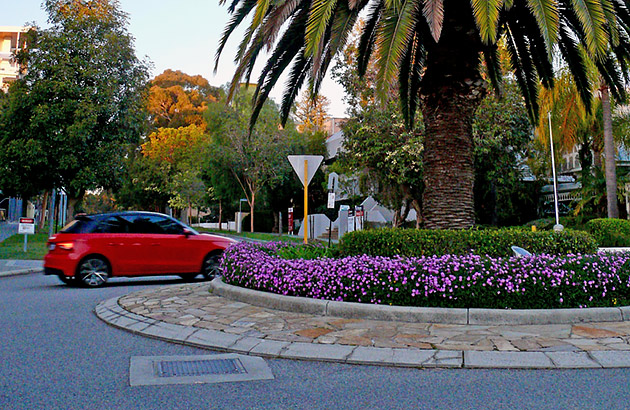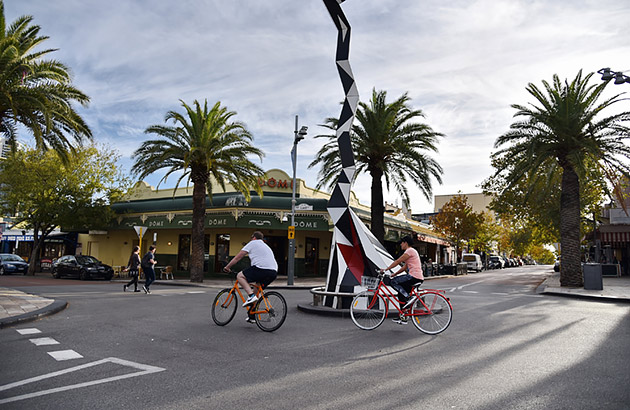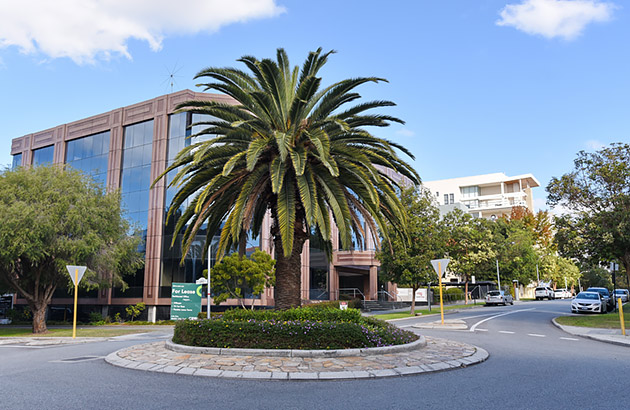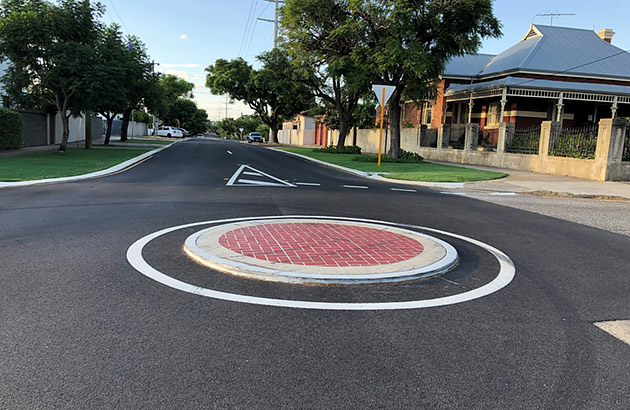19 May, 2022 By: Ruth Callaghan,
An intersection is a risky place. With vehicles travelling in different directions, pedestrians and cyclists crossing, and all moving at different speeds, it’s perhaps no wonder that half the fatalities and serious injuries on metropolitan roads are in crashes that occur at Perth’s more than 50,000 intersections.
While there are several things that can be done to change those statistics, perhaps one of the most controversial for some is to add a roundabout.
Studies across Australia have repeatedly shown that installing roundabouts can cut the overall number of crashes and injury by up to 75 per cent, according to Austroads.
Even when traffic volumes are high, Main Roads WA data shows crash incidence falls by at least half when roundabouts are installed.
But the perception that Perth’s 2900 roundabouts are less safe for some road users persists.
RELATED:
The correct way to use a roundabout »

Who’s saying they’re unsafe?
“Due to the various interactions that happen, urban intersections present a safety concern regardless of the kind of intersection you’re talking about,” says RAC acting general manager of Social Impact, Sarah Macaulay.
“That’s evident from the crash data, and right-angle, side-impact and rear-end crashes are the most common at intersections.
“When we did our last Risky Roads Survey in 2018, asking people to nominate dangerous roads and intersections, 60 per cent of nominations were to do with intersections and our members often raise concerns about interacting with other road users at them.
“In a recent survey, we also asked our members for their views about using roundabouts, and 47 per cent disagree that they’re safe for vulnerable road users such as pedestrians and cyclists.
“When you look at just the responses from regular cyclists, 63 per cent disagree that they’re safe.
“Roundabouts are considered the safest intersection type for vehicular traffic. But the choice and design of an intersection treatment needs to be appropriate for the location, and a range of factors come into play here.”

Figuring out where they work best
Weighing up things like traffic volumes and movements, the mix of road users, the surrounding land uses, topography of the road and space constraints — and balancing a total reduction of crashes, with any potential risk to vulnerable road users— presents a challenge for road safety experts, traffic engineers and urban planners.
Sites are probably less suitable for roundabouts if they are used by very vulnerable users, such as seniors or children, where there are poor lines of sight for oncoming traffic, or where topography means the roundabout could be hidden from view on approach.
The same applies to busy intersections (particularly larger ones) where the traffic flows on different approaches are not balanced, as this can make it hard for vehicles on the less dominant approach to enter the roundabout.
While studies suggest pedestrians might be no more at risk at a roundabout than at other kinds of intersection, they may be more difficult to navigate as there is no general requirement for vehicles or pedestrians to give way to one another. According to Austroads, there is also evidence to suggest roundabouts may be less safe for cyclists and motorcyclists due to drivers failing to see them.
But what is clear is that, where roundabouts can reduce overall travel speed along with the number of collision or ‘conflict’ points and impact angles, any crash that does occur tends to be less serious overall. This is part of the thinking behind a new program that will see more mini roundabouts and other low-cost road treatments rolled-out across Perth.

Zooming in on Perth’s crash hotspots
Jerko Ostoic is director of Road Access and Planning at Main Roads and heads the Low-Cost Urban Road Safety program, working to provide simple but effective changes to the local road network to reduce crashes and save lives.
Unlike traditional black spot programs that largely address locations of significant concern — with a history of lives lost and serious injuries sustained — this program uses Main Roads’ comprehensive database of 51,000 Perth intersections to divide the suburbs into small zones and look at where crashes occur at above average rates.
Between 2015 and 2019, more than 4500 Perth intersections had crashes leading to injuries, and of these, 3500 are on local government roads that are unlikely to meet the criteria for the bigger State or Federal road safety programs.
Main Roads can zoom in on each location, highlighting the number and nature of recent crashes, as well as seeing locations in context — part of a school zone, for example, or close to a busy set of shops.
Working with local governments, Main Roads can then introduce inexpensive measures including, in many cases, mini roundabouts.
How they can reduce crashes
“The biggest positive for roundabouts is the reduction of collision points,” Main Roads’ Jerko Ostoic says.
“If you have a major four-way intersection with a complete set of signals, left turn slip turns, right turns, every movement possible, you have 24 conflict points for traffic.
“A roundabout has only four main collision points. You are either coming in at those four points or you’re not.
“The second major benefit is that it physically separates vehicles from the risk of a head-on crash.
“The third is it reduces speed. If you have those three things, you can still get crashes but your risk of someone being killed or seriously injured is much, much lower.”
Roundabouts also almost eliminate right-angle crashes, which are responsible for 18 per cent of deaths and serious injuries on WA roads.
“At a signalised intersection or T-junction, if someone makes a mistake, you can get hit at right angles which is extremely dangerous,” Ostoic says.
“If you imagine a scenario of a four-way intersection, if I make an error and I miss the stop sign or give way sign, my vehicle could be travelling through at 50km or 60km per hour.
“If I have a moment of misjudgement, and another car hits me at that speed, given it is a right angle, there is a very high probability of someone being killed or seriously injured.
“But at a roundabout you’re coming in at an angle. Even if you make that misjudgement — which really, it is much harder to do — the vehicle coming through is also angled, so there is lower severity.”
Roundabouts in action
The Low-Cost Urban Road Safety program is already changing local streets.
The City of Vincent has recently had nine mini roundabouts added around four suburban blocks, while the City of Stirling is looking to expand the program to Mount Lawley after successfully piloting roundabouts and raised intersection treatments in Joondanna and Osborne Park.

The WA program follows trials in the City of Monash in Victoria, which has installed more than 40 mini roundabouts since 2004. That project saw the number of serious crashes fall from six to none over a three-year period, along with a nearly 80 per cent reduction in total crashes and a reduction in the number of speeding vehicles.
What makes Main Roads’ new approach radically different from other road safety programs, though, is the cost.
To install a traditional large roundabout, including reshaping the road approaches, managing the removal and replacement of services, and adding in landscaping or paving, can cost in the millions of dollars.
In contrast, each City of Vincent mini roundabout cost about $20,000, while in Osborne Park a larger roundabout cost just $30,000.
“The reason they are so cheap is this is just about 80mm of concrete, regulatory signage, and paint,” Ostoic says of the Osborne Park update.
“Yet it changes the driver’s behaviour on approach, and it encourages drivers to slow down and change angle.
“The key is that we have also not touched the curb lines, we haven’t touched the water, Telstra or other services underneath, and we’ve used visual cues to encourage the behaviour we’re after.”
Smart ways to safer roads
Sarah Macaulay says RAC has welcomed the State Government’s funding commitment to date and has been calling for funding towards an ongoing program to deliver such low-cost treatments to encourage safer travel speeds through intersections and address common crash issues across the road network.
While the most dangerous intersections in the state can individually record 40 or more crashes in a year, the local roads targeted under this program are often places where crashes have occurred over a larger area, or where they could occur.
“Serious crashes at more minor intersections on local roads are often more dispersed – you don’t get as many occurring at a single intersection,” Macaulay says.
“You might also have a history of injury crashes at one or several nearby intersections, but the risk profile is potentially very similar for others in the area; you’ve just been lucky and not had a serious crash or fatality at those locations to date.
“If you can apply these low-cost treatments more widely across the network, it can reduce the risk and occurrence of crashes across the board.”
“In designing or redesigning any intersection and its approaches, the safety of all road users must be prioritised. We need to look at innovative ways to make intersections safer for cyclists and improve crossing conditions for pedestrians, because the design of the intersections impacts how safe and comfortable people are using them.”
